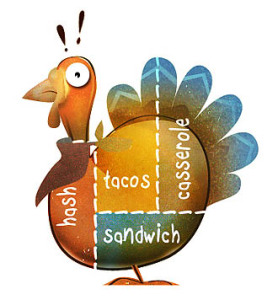No one wants to have to have holiday time overshadowed by a foodborne illness, especially after the Thanksgiving day feast. There are some easy steps to keeping the ‘happy’ in holidays:
- Keep food out of the Danger Zone: Bacteria grow rapidly between the temperatures of 40°F and 140°F. That is what is referred to as the Danger Zone. Hot food must be kept hot at 140°F or warmer to prevent bacterial growth. Within 2 hours of serving, hot leftovers must be refrigerated. You can place hot foods directly in the refrigerator; don’t cool them first on the counter top.
- Cool food quickly: To prevent bacterial growth, it’s important to cool food rapidly so it reaches 40°F or below (the temperature of your refrigerator). To ensure rapid cooling, divide large amounts of food into shallow containers. A 20-pound turkey, for example, will take a long time to cool, inviting bacteria to multiply and increasing the danger of foodborne illness. Instead, slice the turkey and place into shallow containers no more than 3 inches deep, so it will cool quickly. Similarly, remove stuffing from the turkey and place in a pan to cool; gravy also needs to be cooled quickly . A 13″x9″ or similar pan works great for quick cooling. Once food is cooled, it can be repacked into deeper containers, or frozen for longer storage.
- Wrap leftovers well: Once cool, wrap leftovers in airtight packaging or seal them in storage containers. This helps keep bacteria out, retain moisture, and prevent leftovers from picking up odors from other food in the refrigerator.
- Don’t store leftovers too long: Leftovers can be kept in the refrigerator for 3 – 4 days and then should be eaten or put in the freezer. Clearly mark leftovers packaged for the freezer, and plan to store for only 3 – 4 months for optimum quality.
- Reheat safely: When reheating leftovers, check temperature with a food thermometer and make sure food reaches 165°F. Reheat sauces and gravies by bringing them to a rolling boil. Cover leftovers when reheating to help retain moisture and allow the food to heat all the way through. It can be difficult to reheat foods effectively in the microwave oven. Foods that are reheated in the microwave should reach at least 165°F (steaming hot). Of course, some leftovers are just fine eaten cold (turkey sandwiches anyone?).
Sometimes I like to know what I am up against. When considering leftovers, the foodborne pathogen that we are worried about is Clostridium perfringens. C. perfringens causes 1 million foodborne illnesses in the United States each year. Beef, poultry, gravies, and dried or pre-cooked foods are common sources of C. perfringens infections. C. perfringens infection often occurs when foods are prepared in large quantities and kept warm for a long time before serving, or are improperly cooled. People infected with C. perfringens develop diarrhea and abdominal cramps within 6 to 24 hours (typically 8 to 12 hours) of eating mishandled food. The illness usually begins suddenly and lasts for less than 24 hours. This is the one foodborne illness that I have knowingly had! About 6-weeks into my marriage, I cooked a meatloaf in a loaf pan and cooled it on the counter. My husband and I were living in Baton Rouge, LA at the time, and it was summer; the temperature of the room where the meatloaf was ‘cooling’ approached 80°F. It was at least 6 years before I made meatloaf again and, to this day, I rarely include meatloaf in meal plans for my family or friends. Don’t let an illness ruin your holiday plans.
Stay food safe!




